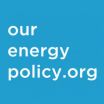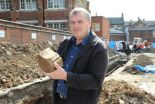(Press-News.org) LIVERMORE, Calif.— U.S. energy policy should simultaneously pursue security of its energy supply, economic stability and reduced environmental impacts, says a national poll of energy professionals jointly prepared by Sandia National Laboratories and OurEnergyPolicy.org.
The findings of the national poll, "The Goals of Energy Policy," show that the vast majority — more than 85 percent — of the 884 energy professionals surveyed prefer policymaking that pursues all three goals at once.
The poll asked the experts to allocate 100 points, representing a 100 percent policymaking effort, across three commonly accepted energy policy goals: the environment, economics and energy supply security. Participating respondents included representatives of public utilities, oil and gas organizations, energy engineering groups and other professional energy associations. Participating organizations were made up primarily of energy professionals and had no overt political or policy agendas related to the three policy goals.
"Creating and implementing energy policy is challenging on many fronts. We hope these results can serve as a useful starting point for those interested in building consensus for an effective energy policy," said Dawn Manley, deputy director of chemical sciences at Sandia.
Matthew Jordan, program director of OurEnergyPolicy.org, said, "Many surveys tend to simplify, rather than clarify, public opinion on energy policy by asking either-or questions. Thinking about energy policy this way is just not leading to results. It may be that the way we talk about energy policy is limiting our ability to develop viable policy options. Our country can and should pursue multiple energy-related goals simultaneously."
Manley added, "There is a growing recognition of the requirement to balance our nation's need for plentiful, low-cost energy with an inherent responsibility to steward the natural environment and to help grow our economy. Surveys like this can help provide strategic direction, guidance and focus for the energy community."
The Sandia-OurEnergyPolicy.org survey asked the following questions:
How should the U.S. allocate its efforts across the following three energy policy priorities?
Energy supply security: Assure a supply of energy for the U.S. that protects our national security interests.
Economics and job creation: Assure a cost for energy that sustains U.S. economic stability and growth.
Environment and climate: Minimize the environmental impacts of energy supply, distribution and use.
Is another energy policy priority needed?
If yes, how would you allocate 100 points across the three original priorities and the fourth, self-selected priority?
The results:
On average, respondents allocated 36.9 points to energy supply security, 32.3 points to economics and job creation and 30.7 points to environment and climate.
Single-issue advocates were rare, with just 3.1 percent of respondents allocating all of their effort toward one goal.
Single-issue adversaries were also few, with less than 15 percent of respondents completely devaluing any one goal.
Male respondents tended to emphasize energy supply security more heavily with increasing age and to de-emphasize the environment with age.
Female respondents prioritized the environment most highly, regardless of age.
Energy supply security rated highest among respondents from Arkansas, Louisiana, Oklahoma and Texas; environment and climate was given the highest priority in the Pacific and New England regions; and compared with other regions, economics and job creation was a higher priority in the Midwest.
Forty-two percent of respondents offered another energy policy goal. Of these, the three most commonly identified were reducing consumption, fostering technological innovation and improving energy efficiency.
Results are presented in a report by Sandia National Laboratories and OurEnergyPolicy.org, which is available on both organizations' websites. Sandia and OurEnergyPolicy.org plan to continue their work on the national energy policy discourse with follow-up surveys and studies on related topics.
INFORMATION:
Sandia National Laboratories is a multiprogram laboratory operated by Sandia Corporation, a wholly owned subsidiary of Lockheed Martin Corporation, for the U.S. Department of Energy's National Nuclear Security Administration. With main facilities in Albuquerque, N.M., and Livermore, Calif., Sandia has major R&D responsibilities in national security, energy and environmental technologies, and economic competitiveness.
OurEnergyPolicy.org's mission is to facilitate substantive, responsible dialogue on energy policy issues and be a resource for the American people, policymakers and the media. By bringing together energy experts in productive national discourse, OurEnergyPolicy.org enhances the potential of adopting and implementing effective energy policy. OurEnergyPolicy.org does not have or endorse any specific political, programmatic, policy or technological agendas.
Sandia media relations contact:
Mike Janes, mejanes@sandia.gov, (925) 294-2447
OurEnergyPolicy.org media contacts:
Claire Buchan, Claire@clairebuchan.com, (202) 257-2329
Alison Harden, aharden@granite-is.com, (202) 436-5565
Sandia, OurEnergyPolicy.org release 'Goals of Energy Policy' poll results
2012-09-12
ELSE PRESS RELEASES FROM THIS DATE:
New paper addresses causes of shattering glass cookware; Margin of safety described as 'borderline'
2012-09-12
A new paper appearing in the September 2012 edition of the Bulletin of The American Ceramic Society for the first time provides a scientific explanation of why some glass cookware sold in the United States is more susceptible than others to "explosive" shattering and the possibility of exposing consumers to injury from flying glass shards.
Clear glass baking dishes and pots are a staple in many households around the world and have been since they were first introduced in 1915 to consumers by the Corning Glass Works, which created the Pyrex brand name. The original Pyrex ...
Old deeds, witness trees offer glimpse of pre-settlement forest in West Virginia
2012-09-12
PARSONS, W. Va., September 12, 2012 – Using old deeds and witness trees, a U.S. Forest Service scientist has created a glimpse of the composition of the forests that covered today's Monongahela National Forest before settlement and logging changed the landscape.
"European Settlement-Era Vegetation of the Monongahela National Forest, West Virginia" describes how a Forest Service scientist and her West Virginia University colleague answered questions about the composition of early forests using a unique dataset. The dataset was built with original deeds, metes and bounds ...
Predicting a die throw
2012-09-12
Vegas, Monte Carlo, and Atlantic City draw people from around the world who are willing to throw the dice and take their chances. Researchers from the Technical University of Lodz, Poland, have spotted something predictable in the seemingly random throw of the dice. By applying chaos theory and some high school level mechanics, they determined that by knowing the initial conditions – such as the viscosity of the air, the acceleration of gravity, and the friction of the table – it should be possible to predict the outcome when rolling the dice.
The researchers created ...
A carefully scheduled high-fat diet resets metabolism and prevents obesity
2012-09-12
New research from the Hebrew University of Jerusalem shows that a carefully scheduled high-fat diet can lead to a reduction in body weight and a unique metabolism in which ingested fats are not stored, but rather used for energy at times when no food is available.
The research was conducted by Prof. Oren Froy along with Prof. Zecharia Madar, research student Yoni Genzer and research fellow Dr. Hadas Sherman at the Institute of Biochemistry, Food Science and Nutrition, at the Hebrew University's Robert H. Smith Faculty of Agriculture, Food and Environment. The results ...
Epigenetics emerges powerfully as a clinical tool
2012-09-12
The research team led by Manel Esteller, director of the Cancer Epigenetics and Biology Program at the Bellvitge Biomedical Research Institute (IDIBELL), professor of genetics at the University of Barcelona and ICREA researcher, has updated the latest findings in applied epigenetics in a review paper published in Nature Reviews Genetics.
There is a growing need for better biomarkers that allow early detection of human diseases, especially cancer. The markers can improve primary prevention, diagnosis and prognosis of disease. Furthermore, it is possible to predict which ...
First pediatric study to look at the role of vitamin D in critical illness
2012-09-12
OTTAWA, Canada, September 12, 2012—Vitamin D is increasingly being recognized as important for good health. Vitamin D is a hormone made in the skin following sun exposure or acquired from diet and supplement intake. Previous medical research has shown that low body levels of vitamin D make people more susceptible to problems such as bone fractures, poor mental health and infections like the common cold. Until recently, there had been little consideration given to the role of vitamin D in more severe diseases, which is why Dr. Dayre McNally's recent publication in the esteemed ...
Study implicates marijuana use in pregnancy problems
2012-09-12
CINCINNATI – New research indicates marijuana-like compounds called endocannabinoids alter genes and biological signals critical to the formation of a normal placenta during pregnancy and may contribute to pregnancy complications like preeclampsia.
A study in the Sept. 14 edition of The Journal of Biological Chemistry offers new evidence that abnormal biological signaling by endocannabinoid lipid molecules produced by the body disrupts the movement of early embryonic cells important to a healthy pregnancy, in particular trophoblast cells that form the placenta. Abnormal ...
King Richard III search in new phase after 'discovery has potential to rewrite history'
2012-09-12
Historic findings of human remains- including a man with apparent battle wounds and curvature of the spine - have been revealed by an archaeological team from the University of Leicester.
The University of Leicester has been leading the archaeological search for the burial place of King Richard III with Leicester City Council, in association with the Richard III Society. The dig, now in its third week, has yielded dramatic findings of human remains which the University will now subject to rigorous laboratory tests.
The stunning findings of human remains excavated by ...
An important breakthrough in the fight against muscular dystrophies
2012-09-12
An important breakthrough could help in the fight against myotonic dystrophy. The discovery, recently published in the prestigious scientific journal Cell, results from an international collaboration between researchers at the IRCM, the Massachusetts Institute of Technology (MIT), the University of Southern California and Illumina. Their findings could lead to a better understanding of the causes of this disease.
Myotonic dystrophy (DM), also known as Steinert's disease, is the most common form of muscular dystrophies seen in adults. This disorder is characterized by ...
Research and development found to be most prevalent in a small number of regions across the country
2012-09-12
Businesses perform a large share of their research and development in a small number of geographic areas, two of the largest being the San Jose-San Francisco-Oakland area and the New York-Newark-Bridgeport area. In these two areas alone, designated as combined statistical areas (CSAs) by the Office of Management and Budget, companies performed at least $29.3 billion of R&D, according to a recent National Science Foundation report.
Data are from the 2008 Business R&D and Innovation Survey (BRDIS). These new BRDIS data allow policymakers and researchers to explore patterns ...



